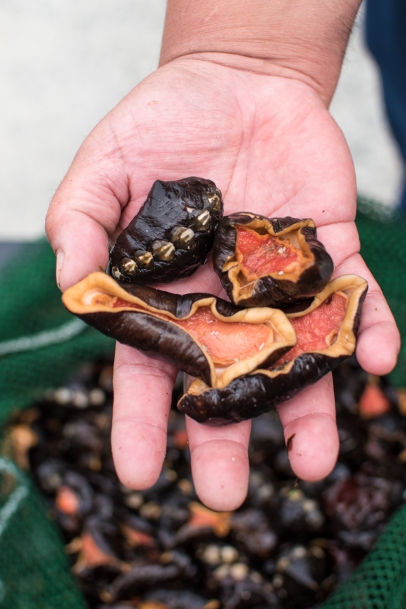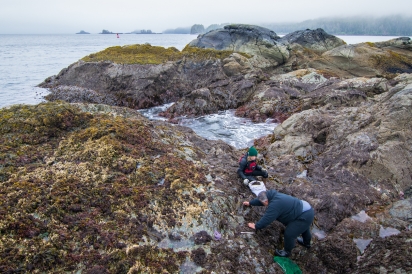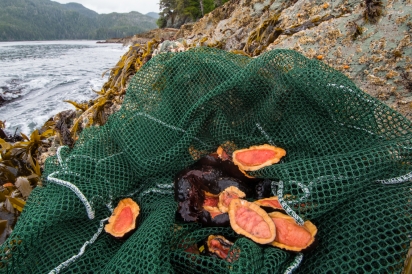Wade in the Water: Harvesting Gumboots and Black Seaweed with Wade Martin
Wade Martin spends more time on the waters around Sitka than anyone I know. He is a Chilkat Tlingit who makes his living hunting otters and seals, selling their pelts to other Coastal Alaskan Natives for use in skin sewing arts. From his 18 ft. open aluminum skiff called the Raven, Wade also fishes and forages seasonal foods across Sitka Sound. He shares this bounty with family and friends throughout Alaska.
A few weeks ago we headed North of Sitka to Salisbury Sound to harvest Black Seaweed (Porphyra abbottiae) and gumboots (chitons). Wade has been harvesting this dynamic duo of intertidal edibles for 38 years.
“We get an early season for black seaweed at the end of March or early part of April, that’s the winter seaweed that has grown. And then we get a second batch in late May. Once it goes past its season the seaweed will just die and fall off the rocks,” says Wade.
The gumboots can be harvested all year long but you will need a low tide to access them with ease. They are not filter feeders and do not carry a risk of Paralytic Shellfish Poisoning.
On the Water
We grab old pillowcases and mesh bags for our soaked and salty bounty. We brought along butter knives and screwdrivers for prying the powerfully clinging gumboots from rocks. Gardening gloves are also helpful for gripping the slippery springy seaweed while protecting soft hands from sharp barnacles.
We pull his skiff up to a set of rocks, coated heavily with a diversity of colorful seaweeds. “It seems like black seaweed likes outer coastal rocks where there is a lot of surge,” notes Wade.
We scramble across the rocks, hunting for gumboots that often hide beneath fronds of kelp or lurk in corners of colorful tide pools. The trick for prying these tough critters from their habitat is to act fast. Aim your screwdriver or butter knife at their base and slip in quickly. Once they feel your approach they often clench up and increase their grip. You wiggle your way in-between the rock and the chiton until they pop off and their alien-like orange underside is revealed.
Black seaweed grows in long, springy strands and clumps. It’s kind of bouncy when you pull it and satisfying when it abandons its grip and pops off the rock in bunches. Harvesting is simple, grip it at the base and yank. Like any good forager, Wade and I are careful to take only what we need and not to over harvest from one site.
This year, black seaweed was scarce. Wade’s typical sites were nearly empty. The rocks where we successfully harvested bags full in 2015, were oddly vacant. We weren’t alone in our struggles. Sitka Tribe of Alaska only harvested 1/10th the amount they were able to forage last year. My colleagues and friends in Kasaan and Hydaburg reported a startlingly scarce harvest while Kake reported a successful year. In Wade’s decades of local experience, he does not remember a single season as scarce as this. Whether this is a trend due to our changing climate or just an unfavorable local year, nobody can be sure. Wade and other locals are keeping their eyes to their favorite local harvest site in hopes that a late crop of seaweed may surprise us with a prolific bounty. Scarce harvest seasons remind us how fragile our local landscapes are and how dependent we are on them for nutrition and soul food.
Processing Techniques
Black Seaweed
-
Freeze the seaweed in ziplock bags for a sunny day
-
Once the sun comes out, spread the seaweed out and dry it to the point where it is dried enough to grind
-
Grind the seaweed using a hand grinder and then spread back out in the sun, tossing the seaweed every so often and breaking it into the size pieces you want
-
Once sun dried, place the seaweed on pans and roast in the oven until it is nice and crunchy (some people toss in additional flavorings like sesame oil)
-
Enjoy as a chip-like snack on it’s own, mix it into recipes, grind it further and keep in a salt shaker and sprinkle it on snacks or in soups
Chitons/Gumboots
-
Toss the gumboots in a large pot with about an inch or two of water
-
Cover with a lid and steam the gumboots being careful not to cook them for too long or else they might get tough
-
Pull the shells out from their backs, many people save these and use them for a future art project
- You can eat them raw, try them in chowder recipes, dip them in seal oil, pickle them or get creative and try something new - let us know how you enjoy gumboots!









